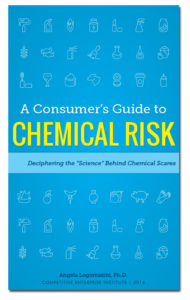 You’ve probably heard the claims that chemicals are disrupting our hormones. They disrupt the development of babies in the womb, childhood development, our learning ability, and they make us fat.
You’ve probably heard the claims that chemicals are disrupting our hormones. They disrupt the development of babies in the womb, childhood development, our learning ability, and they make us fat.
But none of it is true.
Having largely lost the intellectual debate on cancer (although their spurious claims still adversely affect policy), anti-chemical activists have decided to add more tools to their arsenal. Among their most powerful tools is the claim that chemicals are causing widespread problems by disrupting the endocrine systems of humans and wildlife. Accordingly, activists argue that we should ban or heavily regulate various chemicals, particularly pesticide products, on the basis of assertions that such chemicals may have an endocrine-related effect.
Endocrine systems in both humans and animals consist of a series of glands that secrete hormones and send messages throughout the body. Working in conjunction with the nervous system, these messages trigger various responses, such as growth, maturation of reproductive systems, and contractions during pregnancy. Foreign chemicals can disrupt proper functioning of the endocrine system and lead to health problems. Environmentalists refer to such external chemicals as endocrine disrupters, but others use more neutral terms because not all effects are negative or substantial. The American Council on Science and Health (ACSH) calls them endocrine modulators, which is the term used in the subsequent discussion.(1) The National Research Council calls them “hormonally active agents.”(2)
The endocrine disrupter alarm tactic focuses primarily on synthetic chemicals. Allegedly, because we have used and continue to use man-made chemicals—particularly a class of chemicals called organochlorines, such as DDT (dichloro-diphenyl-trichloroethane) and PCBs (polychlorinated biphenyls)—the public and wildlife are widely suffering with everything from infertility and cancer to neurological disorders and developmental problems. But before rushing to ban and regulate all man-made chemicals, policymakers should review some facts. To help place the issue in perspective, this section gives an overview of the following key points:
- Scientific studies have not found any definitive adverse impacts to humans related to endocrine modulators in the environment.
- There are other, more significant sources of endocrine modulators than industrial chemicals, indicating that the risks of industrial chemicals are tiny in comparison.
- Effects on wildlife from industrial chemicals appear to have occurred, but they have been isolated events rather than widespread phenomena, and they have been related to relatively high-level exposures.
- Cases in which wildlife may have been affected have declined considerably because the level of industrial endocrine modulators in the environment has declined, thereby reducing problems for wildlife.
Concerns about endocrine disrupters arose in part after women who took the drug diethylstilbestrol (DES) experienced higher incidences of reproductive tract problems. Between 1940 and 1970, many women took DES to prevent miscarriages. The relevance of these cases to low-level environmental exposures or to other potential endocrine modulators is highly tenuous, as many researchers have pointed out:
- Toxicologist Stephen Safe notes: “DES is not only a potent estrogen, but it was administered at relatively high doses.… In contrast, synthetic environmental endocrine-disrupting compounds tend to be weakly active.”(3)
- A panel of scientists reported to the American Council on Science and Health: “Aside for exposure itself, perhaps the two most important factors are potency and dose.”(4) The ACSH report notes that putting environmental exposures to synthetic chemicals in perspective requires that we compare the potency of such chemicals to that of the man-made estrogen, 17b-estradiol. Scientists have found the synthetic chemicals DDT and PCBs (the most studied chemicals claimed to be endocrine disrupters) to be up to 1 million times less potent than 17b-estradiol.(5)
- The National Research Council reported that it lacks data showing that “hormonally active” compounds cause any adverse impacts.(6)
Nature’s Hormone Factory(7)
Ironically, the entire theory that industrialization is causing severe endocrine disruption falls apart when you consider exposures to naturally occurring endocrine modulators. Plants naturally produce endocrine modulators called phytoestrogens, to which we are exposed at levels that are thousands and sometimes millions of times higher than those of synthetic chemicals. Humans consume these chemicals every day without adverse effects, and some contend that these chemicals promote good health. Consider these facts:
- Hundreds of plants appear to contain endocrine modulators, and lab tests have discovered endocrine modulators in 43 foods in the human diet, including corn, garlic, pineapple, potatoes, and wheat.(8)
- Soy products, particularly soybean oil, are found in hundreds of products, many of which we safely consume on a regular bas
 is.(9)
is.(9) - Although we safely consume them, phytoestrogens, are 1,000 to 10,000 times more potent than synthetic estrogens. Because we consume far more phytoestrogens in our diet, the estrogenic effects of the total amount we consume are as much as 40 million times greater than those of the synthetic chemicals in our diets. Nevertheless, they are safe.(10)
In addition, the estrogen that our bodies create, 17b-estradiol, which is included in oral contraceptives, may be entering waterways by passing through sewage treatment facilities. The effects of this chemical on wildlife are not yet clear. However, studies in some British rivers showed that natural hormones (17bestradiol and estrone) and a component of birth control pills (ethynylestradiol) were responsible for estrogenized male fish. (11) Even though they may have a greater impact on wildlife because they are far more potent, natural hormones are not a large part of the debate related to environmental estrogens.
In fact, when the U.S. Environmental Protection Agency (EPA) set standards for its program to screen environmental estrogens (a program required under the Food Quality Protection Act), the committee refused to consider phytoestrogens and has delayed considering effects from contraceptives. Instead, it will screen and test only “pesticide chemicals, commercial chemicals, and environmental contaminants.”(12) When and if it considers the impacts of oral contraceptives as environmental contaminants, the EPA says its consideration will be limited because pharmaceutical regulation is a Food and Drug Administration concern.
As a result, the EPA’s program will focus on the smallest possible part of endocrine exposure and the lowest area of risk. It serves regulators’ interests to leave consideration of both naturally occurring estrogens as well as oral contraceptives out of the picture. If they did screen for them, the massive amounts would dwarf those of pesticides and other chemicals they regulate, demonstrating that low-level exposure to commercially related endocrine modulators is relatively insignificant—a fact that would undermine the EPA’s ability to regulate commercial products on the allegation that they are a significant source of endocrine disruption.
Declining Sperm Counts More Myth Than Reality
Yet more consternation resulted when Danish researchers conducted a statistical analysis of 61 papers that included data on male sperm counts. They reported a “significant decline in mean sperm count” between 1940 and 1990.(13) But they noted, it was unclear whether environmental estrogens were involved.
Adding fuel to the fire, researchers Richard Sharpe and Niels E. Skakkebaek made stronger suggestions that endocrine modulators play a role in alleged sperm count declines. In one article, the authors asserted that “a strong mechanistic case can be made” to explain how endocrine modulators could affect male reproductive functions.(14) Although merely a series of speculations, this article and subsequent statements by the authors have sparked continued mainstream press coverage and have become key sources for those who claim that manmade chemicals are reducing sperm counts. But problems with these papers abound:
First, the 1992 Danish meta-analysis, which is the basis of the declining sperm count claims, garnered criticism for numerous flaws, including the authors’ selection of data that left out low sperm counts in the early dates, simply creating the illusion that sperm counts in the later dates were lower.(15)
- Others suggested that problems with data emerged because the authors included studies with samples that were far too small and that “would not normally be admissible as evidence.”(16)
- Claims drawn from the 61 study metaanalysis grew even more suspect when other researchers conducted their own analysis of a subset of those studies. This analysis considered the 48 studies published since 1970, leaving out some of the earlier studies because the data were too few to produce a useful analysis. This approach found that male sperm counts have actually increased between 1970 and 1990—contradicting claims that sperm counts were decreasing in recent decades.(17)
- To complicate matters further, although some additional studies do suggest falling sperm counts, other studies have undermined those findings by reporting no change or an increase in sperm counts.(18)
- Claims of declining sperm counts remain largely speculative. Even Sharpe, one of the strongest believers in potential sperm declines, notes “it is only a hypothesis.” He defends the hypothesis only on the idea that “all the facts fit” (despite many findings to the contrary).(19)
Dubious Breast Cancer Claims
As in the prior case, concerns about breast cancer caused by endocrine modulators arose with the publication of one key study. This time, it was a 1993 study led by Mount Sinai Medical School Professor Mary Wolff that compared DDT levels in the body fat of 58 women diagnosed with breast cancer with 171 control subjects.(20) Although the sample was still small, the Wolff study was larger than prior studies, only one of which had more than 20 subjects. Wolff and her colleagues found higher levels of DDE (dichloro-diphenyl-dichloroethylene, the metabolite of DDT) in breast cancer victims, indicating an association between the two phenomena.
Although it included phrases of caution (“these findings are novel” and “require confirmation”), the study was full of other, more explosive rhetoric. In the conclusion, the authors make strong statements about their “findings” (which lump together all organochlorine substances even though the study focused only on DDT metabolites) and make a plea for government action:
Our observations provide important new evidence related to low-level environmental contaminants with organochlorine residues to the risk of breast cancer in women. Given widespread dissemination of organochlorines in the environment, these findings have immediate and far-reaching implications for public health intervention worldwide.(21)
As Stephen S. Sternberg, pathologist with Sloan-Kettering Cancer Center, noted, “With these statements, one can hardly consider that the investigators reported their conclusions cautiously.” The result was media hype about breast cancer risks. “The jury isn’t in, yet you would never know it from the media reports,”(22) said Sternberg. Further criticism of the study quickly appeared in the scientific literature:
- Regarding the key breast cancer study alleging endocrine risks, one group of researchers noted: “Their literature review excluded substantial conflicting evidence, their discussion of the Serum DDE and PCB measurements and the case-control analysis excluded important details, and their dose-response analysis, given their data used an inappropriate method. Also we do not believe that their data support their conclusion of a relationship between breast cancer and organochlorines as a class.”(23)
- The National Research Council also noted the following problems with the breast cancer study: the size of the study was too small to provide much conclusive information, methodological problems could mean that the disease was causing higher levels of DDE rather than the other way around, and adjustments that the Wolff study made to account for alleged losses of DDE levels because of lactation may have been inappropriate (controlling for these variables substantially increased estimated DDE levels in cancer victims).(24)
- Ironically, Wolff, who remains an advocate of the view that organochlorines likely play a role in breast cancer and other diseases,(25) participated in other studies that failed to find associations.(26)
- The National Research Council concluded that the Wolff study and all the ones published before 1995 “do not support an association between DDT metabolites or PCBs and the risk of breast cancer.”(27)
- Subsequent studies further undermine cancer claims.(28) Key among those was a study of 240 women with breast cancer and a control group of the same size, which could not find a link.(29)
- Another study of more highly exposed populations in Mexico, where DDT had been used for insect control, found no significant difference in DDE levels among control and breast cancer groups.(30)
- Accordingly, the National Research Council concluded the following about the studies conducted after 1995: “Individually, and as a group, these studies do not support an association between DDE and PCBs and cancer in humans.”(31)
Wildlife-Related Problems: Isolated to High-Level Exposures
Certain wildlife appears to have been affected by high exposures to certain man-made chemicals, leading to developmental and reproductive problems. In one study, alligators in Lake Apopka that were exposed to very high levels of sulfuric acid and pesticides from a nearby spill suffered from reduced hatching, small phallus size, and reduced life spans.(32) Other studies have found similar problems in the Great Lakes. However, one should look at these studies with caution before concluding that such problems are widespread or that man-made chemicals cause every endocrine-related problem. For example, many studies have claimed that pesticides are causing deformities in frogs in various places around the country, but other factors may come into play. One study revealed another possible cause: parasites.(33)
Also of note, phytoestrogens can have similar effects. Agricultural researchers and farmers have discovered some problems and have mitigated the effects of such chemicals to protect their livestock. For example, Competitive Enterprise Institute’s Jonathan Tolman noted that the Australian Department of Agriculture discovered in 1946 that natural endocrine modulators in clover had caused sheep sterility.(34) Fortunately, cases of wildlife being affected by endocrine modulators are relatively isolated. Moreover, the amount of certain endocrine modulators—those that environmental activists hype the most—are becoming less concentrated in the environment. This is happening despite the fact that environmentalists have claimed these products were persistent, meaning they would not dissipate. The National Research Council reports that, while there are some exceptions, concentrations are in fact declining:
The concentrations of some regulated halogenated organic compounds have decreased since the 1970s. For many other chemicals, there are inadequate data upon which to evaluate trends. The most studied chemicals are PCBs and DDT and the production of these has been banned in the United States for the past 20 years, resulting in declines in environmental concentrations. Examples include progressive and substantial decline in PCBs and DDT found in eggs taken from bird colonies in the Canadian Atlantic region between 1972 and 1978 and decrease in PCBs and DDT in Bering Sea fish from 1982 to 1992.”(35)
(1) ACSH, Endocrine Disrupters: A Scientific Perspective (New York: ACSH, 1999), 9.
(2) National Research Council, Hormonally Active Agents in the Environment (Washington, DC: National Academies Press, 1999).
(3) Stephen Safe, “Endocrine Disrupters: New Toxic Menace?” in Earth Report 2000 (New York: McGraw- Hill, 2000), 192.
(4) ACSH, Endocrine Disrupters: A Scientific Perspective, 11.
(5) Ibid., 14–15.
(6) National Research Council, Hormonally Active Agents in the Environment.
(7) This title is borrowed from Jonathan Tolman, Nature’s Hormone Factory: Endocrine Disrupters in the Natural Environment (Washington DC: Competitive Enterprise Institute, March 1996)
(8) Tolman, Nature’s Hormone Factory, 4–5.
(9) Ibid., 5.
(10) Tolman, Nature’s Hormone Factory, 8. Figures are derived from research of Stephen Safe, “Environmental and Dietary Estrogens and Human Health: Is There a Problem?” Environmental Health Perspectives 103, no. 4 (1995): 349.
(11) C. Desbrow, E. J. Routledge, G. C. Brighty, J. P. Sumpter, and M. Waldock, “Identification of Estrogenic Chemicals in STW Effluent,” Environmental Science and Technology 32, no. 11 (1998): 1549–58.
(12) EPA, Office of Science Coordination and Policy, Endocrine Disrupter Screening Program: Report to Congress (Washington, DC: EPA, August 2000) 6; EPA; the Agency also notes that its second list of chemicals for screening under the program continues to exclude naturally occurring hormones and human hormones; see “Overview of the Second List of Chemicals for Tier 1 Screening,” EPA web document, updated August 11, 2011, accessed online on January 27, 2012, .
(13) Elisabeth Carlsen, Aleksander Giwercman, Niels Keiding, and Niels E. Skakkebaek, “Evidence for Decreasing Quality of Semen during the Past 50 Years,” British Medical Journal 305, no. 6854 (1992): 609.
(14) Richard M. Sharpe and Niels E. Skakkebaek, “Are Oestrogens Involved in Falling Sperm Counts and Disorders of the Male Reproductive Tract?” Lancet 341, no. 8857 (1993): 1392.
(15) Peter Bromwich, Jack Cohen, Ian Stewart, and Andrew Walker, “Decline in Sperm Counts: An Artifact of Changed Reference Range of ‘Normal’?” British Medical Journal 309, no. 6946 (1992): 19.
(16) Anna Brake and Walter Krause, “Decreasing Quality of Semen; Letter: Comment,” British Medical Journal 305, no. 6867 (1992): 1498.
(17) Stuart Irvine, Elizabeth Cawood, David Richardson, Eileen MacDonald, and John Aitkin, “Evidence of Deteriorating Semen Quality in the United Kingdom: Birth Cohort Study in 577 Men in Scotland over 11 Years,” British Medical Journal 312, no. 7029 (1996): 467.
(18) L. Bujan, A. Mansat, F. Fontonnier, and R. Mieusset, “Time Series Analysis of Sperm Concentration in Fertile Men in Toulouse, France, between 1977 and 1992,” British Medical Journal 312, no. 7029 (1996): 417. See also Geary W. Olsen, Charles E. Ross, Kenneth M. Bodner, Larry I. Lipshultz, and Jonathan M. Ramlow, “Have Sperm Counts Been Reduced 50 Percent in 50 Years? A Statistical Model Revisited,” Fertility and Sterility 63, no. 4 (1995): 887–93.
(19) As quoted by Gail Vines, “Some of Our Sperm Are Missing: A Handful of Six Chemicals Are Suspected of Disrupting Male Sex Hormones, but Are These Oestrogens Really the Environmental Evil They Seem?” New Scientist, August 26, 1995, 23.
(20) Mary S. Wolff, Paolo G. Toniolo, Eric W. Lee, Marilyn Rivera, and Neil Dubin, “Blood Levels of Organochlorine Residues and Risk of Breast Cancer,” Journal of the National Cancer Institute 85, no. 8 (1993): 648–52.
(21) Ibid.
(22) Stephen S. Sternberg, “DDT and Breast Cancer, Correspondence,” Journal of the National Cancer Institute 86 no. 14 (1994): 1094–96.
(23) John F. Acquavella, Belinda K. Ireland, and Jonathan M. Ramlow, “Organochlorines and Breast Cancer, Correspondence,” Journal of the National Cancer Institute 85, no. 22 (1993): 1872–75.
(24) National Research Council, Hormonally Active Agents in the Environment, 248–49.
(25) For example, see Mary S. Wolff and Ainsley Weston, “Breast Cancer Risk and Environmental Exposures,” Environmental Health Perspectives 105, suppl. no. 4 (1997): 891–96.
(26) Nancy Krieger, Mary S. Wolff, Robert A. Hiatt, Marilyn Rivera, Joseph Vogelman, and Norman Orentreich, “Breast Cancer and Serum Organochlorines: A Prospective Study among White, Black, and Asian Woman,” Journal of the National Cancer Institute 86, no. 8 (1994): 589–99.
(27) National Research Council, Hormonally Active Agents in the Environment, 250.
(28) For an overview of many key studies, see Stephen Safe, “Endocrine Disrupters and Human Health: Is There a Problem? An Update,” Environmental Health Perspectives 108, no. 6 (2000): 487–93.
(29) David J. Hunter, Susan E. Hankinson, Francine Laden, Graham A. Colditz, JoAnn E. Manson, Walter C.Willett, and Frank E. Speizer, “Plasma Organochlorine Levels and the Risk of Breast Cancer,” New England Journal of Medicine 337, no. 18 (1997): 1253–58.
(30) Lizbeth López-Carrillo, Aaron Blair, Malaquías López-Cervantes, Mariano Cebrián, Celina Rueda, Raúl Reyes, Alejandro Mohar, and Jaime Bravo, “Dichlorodiphenyltrichloroethane Serum Levels and Breast Cancer Risk: A Case-Control Study from Mexico,” Cancer Research 57, no. 17 (1997): 3728–32.
(31) National Research Council, Hormonally Active Agents in the Environment, 272.
(32) Louis J. Guillette Jr., Timothy S. Gross, Greg R. Masson, John M. Matter, H. Franklin Percival, and Allan R. Woodward, “Developmental Abnormalities of the Gonad and Abnormal Sex Hormone Concentrations in Juvenile Alligators from Contaminated and Control Lakes in Florida,” Environmental Health Perspectives 102, no. 4 (1994): 680–88.
(33) Pieter T. J. Johnson, Kevin B. Lunde, Euan G. Ritchie, and Alan E. Launer “The Effect of Trematode Infection
on Amphibian Limb Development and Survivorship,” Science 284, no. 5415 (1999): 802–4. For an overview of the issue, see Brian Doherty, “Amphibian Warfare,” Weekly Standard, May 24, 1999, 16–18.
(34) Tolman, Nature’s Hormone Factory, 1.
(35) National Research Council, Hormonally Active Agents in the Environment, 66–67.
Last updated: February 6, 2012. The original text for this article was drawn from Angela Logomasini, “Endocrine Disrupters,” in Environmental Source, eds., Angela Logomasini, Ph.D. and David Riggs, Ph.D., Competitive Enterprise Institute, 2002 (1st ed.), 2008 (2nd ed.).


